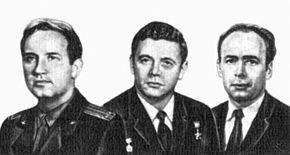Our website is made possible by displaying online advertisements to our visitors.
Please consider supporting us by disabling your ad blocker.
Soyuz 11
 Soyuz 11 on a 1971 commemorative stamp of the Soviet Union | |
| Mission type | Dock with Salyut 1 |
|---|---|
| Operator | Soviet space program |
| COSPAR ID | 1971-053A |
| SATCAT no. | 05283 |
| Mission duration | 23 days, 18 hours, 21 minutes, 43 seconds |
| Orbits completed | 383 |
| Spacecraft properties | |
| Spacecraft | Soyuz, 7K-T No. 32[1] |
| Spacecraft type | Soyuz 7K-OKS |
| Manufacturer | OKB-1 |
| Launch mass | 6,565 kg (14,473 lb)[2] |
| Landing mass | 1,200 kg (2,600 lb) |
| Crew | |
| Crew size | 3 |
| Members | |
| Callsign | Янтарь (Yantar – "Amber") |
| Start of mission | |
| Launch date | 6 June 1971, 04:55:09 UTC |
| Rocket | Soyuz |
| Launch site | Baikonur, Site 1/5[3] |
| End of mission | |
| Landing date | 29 June 1971, 23:16:52 UTC |
| Landing site | 90 km (56 mi) southwest of Karazhal, Karaganda Oblast, Kazakh SSR, Soviet Union (47°21′23″N 70°07′16″E / 47.35639°N 70.12111°E) |
| Orbital parameters | |
| Reference system | Geocentric orbit[4] |
| Regime | Low Earth orbit |
| Perigee altitude | 185 km (100 nmi; 115 mi) |
| Apogee altitude | 217 km (117 nmi; 135 mi) |
| Inclination | 51.6° |
| Period | 88.3 minutes |
| Docking with Salyut 1 | |
| Docking date | 7 June 1971 |
| Undocking date | 29 June 1971, 18:28 UTC[2] |
| Time docked | 22 days |
 Zvezda Rocket  Left to right: Dobrovolsky, Volkov and Patsayev | |
Soyuz 11 (Russian: Союз 11, lit. 'Union 11') was the only crewed mission to board the world's first space station, Salyut 1.[a][5] The crew, Georgy Dobrovolsky, Vladislav Volkov, and Viktor Patsayev,[6][7][8] arrived at the space station on 7 June 1971, and departed on 29 June 1971. The mission ended in disaster when the crew capsule depressurised during preparations for re-entry, killing the three-person crew.[9] The three crew members of Soyuz 11 are the only humans to have died in space.[b][10]
- ^ Cite error: The named reference
russianspacewebwas invoked but never defined (see the help page). - ^ a b Cite error: The named reference
Displaywas invoked but never defined (see the help page). - ^ "Baikonur LC1". Encyclopedia Astronautica. Archived from the original on 15 April 2009. Retrieved 4 March 2009.
- ^ Cite error: The named reference
Trajectorywas invoked but never defined (see the help page). - ^ "Mir Hardware Heritage/Part 1 - Soyuz". en.wikisource.org.
- ^ "Soyuz 11". Encyclopedia Astronautica. 2007. Archived from the original on 28 December 2016. Retrieved 20 October 2007.
- ^ Trivedi, Mamta (2001). "30 Years Ago: The World's First Space Station, which was Salyut 1". Space.com. Archived from the original on 6 June 2001. Retrieved 20 October 2007.
- ^ "After glory era, cash woes hobble Russian space program". CNN. 27 June 1997. Retrieved 20 October 2007.
- ^ "Triumph and Tragedy of Soyuz 11". Time. 12 July 1971. Archived from the original on 18 March 2008. Retrieved 20 October 2007.
- ^ "Space disasters and near misses". Channel 4. Archived from the original on 12 October 2008. Retrieved 29 June 2011.
Cite error: There are <ref group=lower-alpha> tags or {{efn}} templates on this page, but the references will not show without a {{reflist|group=lower-alpha}} template or {{notelist}} template (see the help page).
Previous Page Next Page


